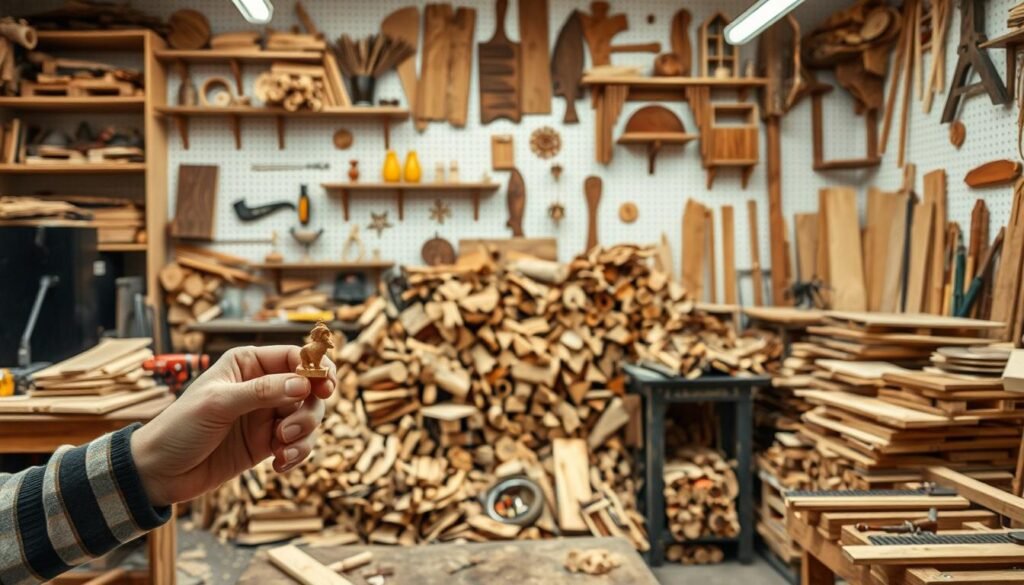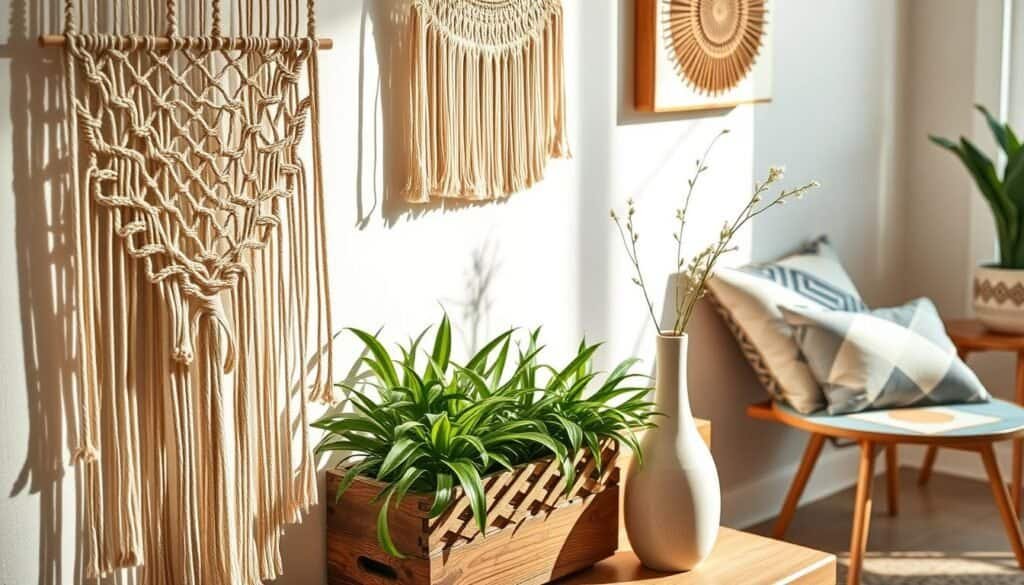Introducing your children to woodworking can be very rewarding. It helps them grow creatively and build skills. Plus, it’s a great way to spend quality time together.
Woodworking projects for kids improve their problem-solving and hand-eye coordination. They get to make something cool while learning.
These projects are simple, fun, and educational. They’re perfect for beginners. Your kids will love making something with their own hands.
Woodworking teaches kids about the craft and boosts their confidence. It’s a chance to make memories that will last a lifetime.
The Benefits of Woodworking for Children
Woodworking projects can change kids’ lives, teaching them important skills and helping them grow. Kids learn a lot from doing woodworking, gaining benefits that last long after they leave the workshop.
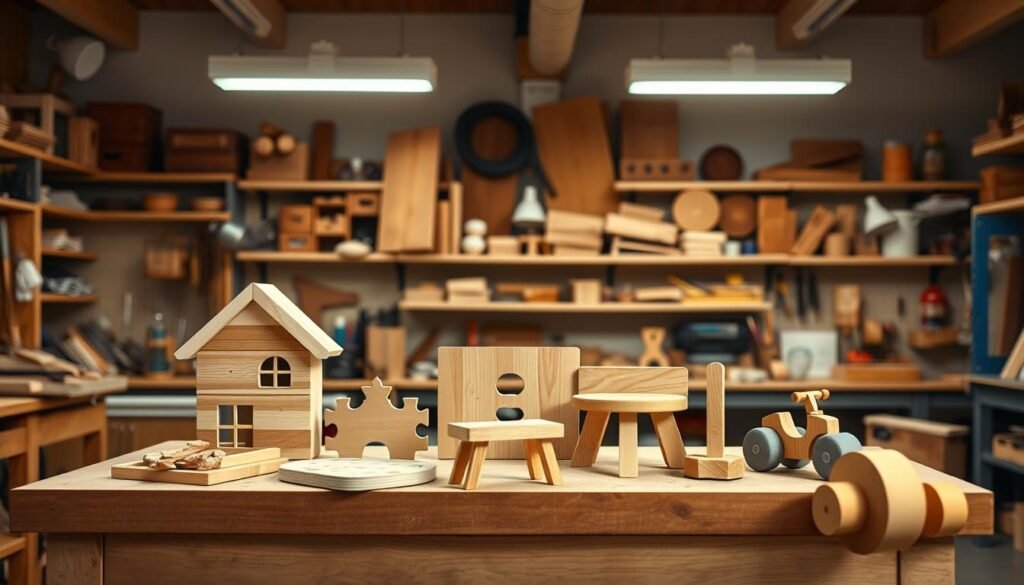
Woodworking helps kids develop practical skills. They learn to measure, cut, and put wood together. This improves their hand-eye coordination and fine motor skills.
Enhancing Creativity and Problem-Solving
Woodworking projects boost kids’ creativity and problem-solving skills. When kids design and build, they think deeply about their ideas. They make changes as they go, learning to solve problems.
Simple projects like building a birdhouse or picture frame are very rewarding. They teach kids about woodworking and make them feel proud of their work.
Woodworking gives kids a strong base for future skills. It’s a chance for kids to learn, create, and grow through hands-on activities.
Safety First: Essential Guidelines for Kid-Friendly Woodworking
Woodworking is fun and educational for kids. It helps them develop motor skills and creativity. But, it’s important for them to know and follow safety rules.
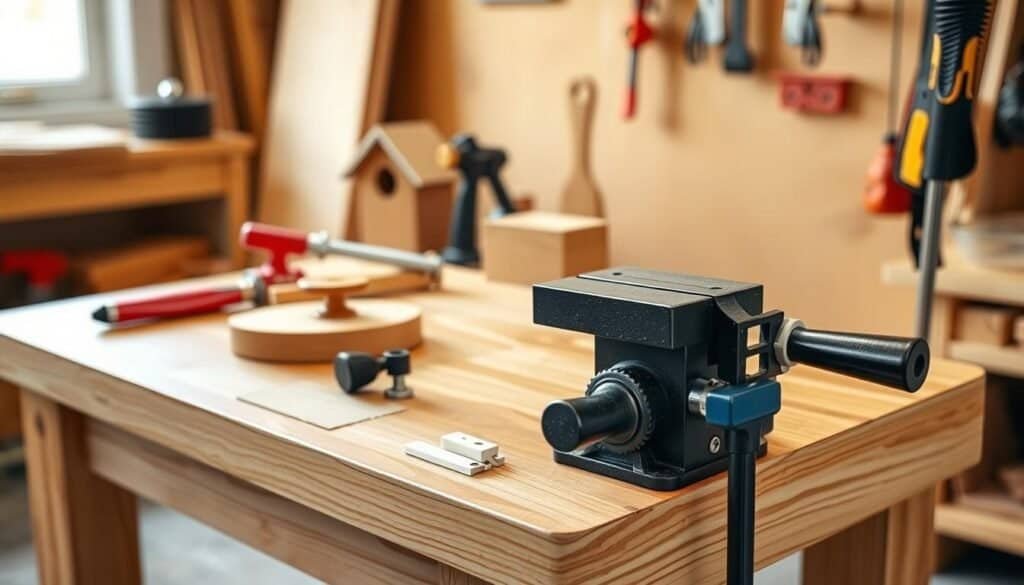
Creating a safe workspace for kids is essential. The area should be well-lit and clean. This reduces the chance of accidents. Kids also need to learn how to use tools safely.
Supervision and Safety Equipment
When kids work on wood projects, an adult should be there. They can guide and make sure kids use safety gear right. Safety goggles, gloves, and a dust mask protect them from dangers.
Teaching kids about safety gear is important. Show them how to wear safety goggles and gloves. Explain why a dust mask is needed with certain materials.
By focusing on safety and supervision, kids can have fun woodworking. They’ll learn important skills in a safe place. This safety knowledge will help them with more complex projects later.
Essential Tools and Materials for Kids’ Woodworking Projects
Woodworking with kids needs careful tool and material selection. It’s important to pick tools that fit their age and are easy to use. This ensures a safe and fun experience.
For beginners, tools like a kid-friendly hammer, small saw, and sandpaper are key. They help kids develop their motor skills and learn woodworking basics. Softwoods like pine or cedar are best for kids because they’re easy to work with and don’t splinter.
Choosing the Right Materials
Choosing the right materials is key for kids’ woodworking projects. Wooden planks, dowels, and pre-cut wood are perfect for easy wood crafts and wood crafts for kids. Also, using non-toxic finishes and paints makes the projects safe for kids.
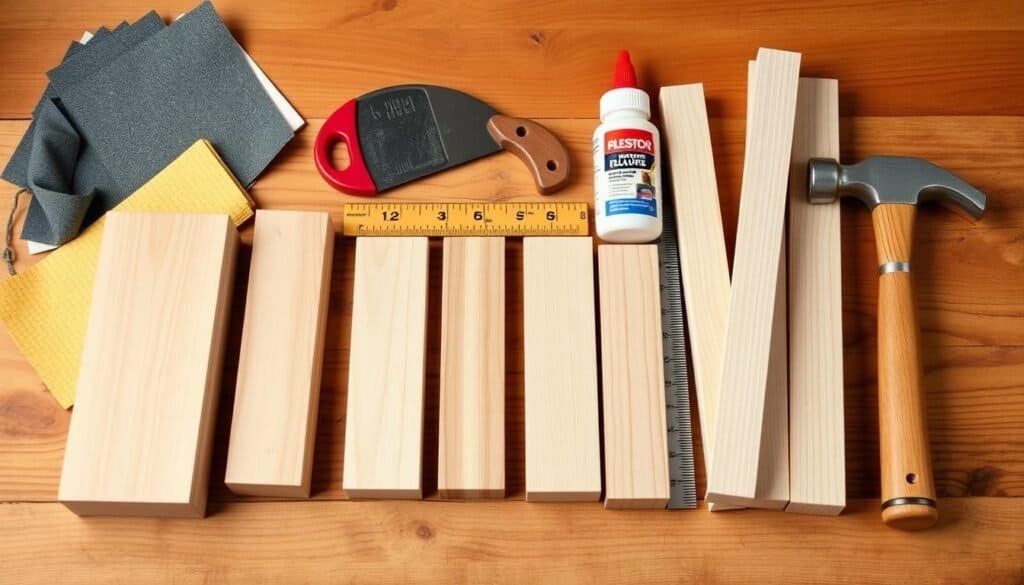
Popular projects for kids include making children toys, wood baby toys, and wooden children’s toys. These projects boost creativity and teach important skills. Starting with simple projects and moving to harder ones helps kids grow their skills and confidence.
By picking the right tools and materials, parents and teachers can make woodworking fun and educational for kids. This can spark a lifelong love for woodworking and crafting.
Simple Birdhouse: Perfect for Ages6-8
Building a simple birdhouse is a fun project for kids aged 6-8. It teaches them about woodworking and helps them love nature. They learn to measure, cut, and assemble wooden pieces, just like in making montessori wooden toys.
To start, kids need to gather materials like wooden planks, a hammer, nails, and a saw. It’s important to pick wood that’s safe and easy for them to work with. This project is also a chance to talk about using sustainable materials, like in wooden educational toys.

After building the birdhouse, kids can make it their own. They can paint it bright colors or add decorations, like on princess toys. This makes the birdhouse more attractive to birds and adds a personal touch.
They can also try different designs or shapes, making the birdhouse a wooden sculpture. This boosts their creativity and shows them the many designs possible in woodworking, similar to diy montessori toys.
Building a birdhouse is a great way for kids to learn about woodworking, nature, and making something with their hands. It’s a fun project that the whole family can enjoy together, creating memories that last.
Wooden Picture Frames: Creative Project for Ages7-10
Kids aged 7-10 can have fun making wooden picture frames. It’s a great way for them to be creative and learn woodworking. They can make something special for their loved ones.

First, kids can pick the wood they like. They might choose pine or go for something unique like driftwood. This makes the frame stand out as “wood decor.”
Adding a Personal Touch
One of the best parts is adding personal touches. Kids can decorate with nails, shells, or fabric. They can also try different stains or paints for a unique color. These “wood creations” can be gifts or add to their room’s look.
For those who want to sell their work, these frames can be a great start. It’s a chance for kids to show their business side. Plus, using “scrap wood ideas” is good for the environment and saves money.
This project teaches kids about woodworking and the joy of making something themselves. They can be proud of their “wood creations” and enjoy seeing their ideas come to life.
Fun and Easy Woodworking Projects Kids Can Build and Learn From: Tabletop Bookshelf
A tabletop bookshelf is a great project for kids. It teaches them about organization and woodworking. It’s fun and helps improve problem-solving and hand-eye coordination.
To begin, you’ll need basic tools and materials like reclaimed wood or plywood. You can also use scrap wood, making it a good way to recycle.
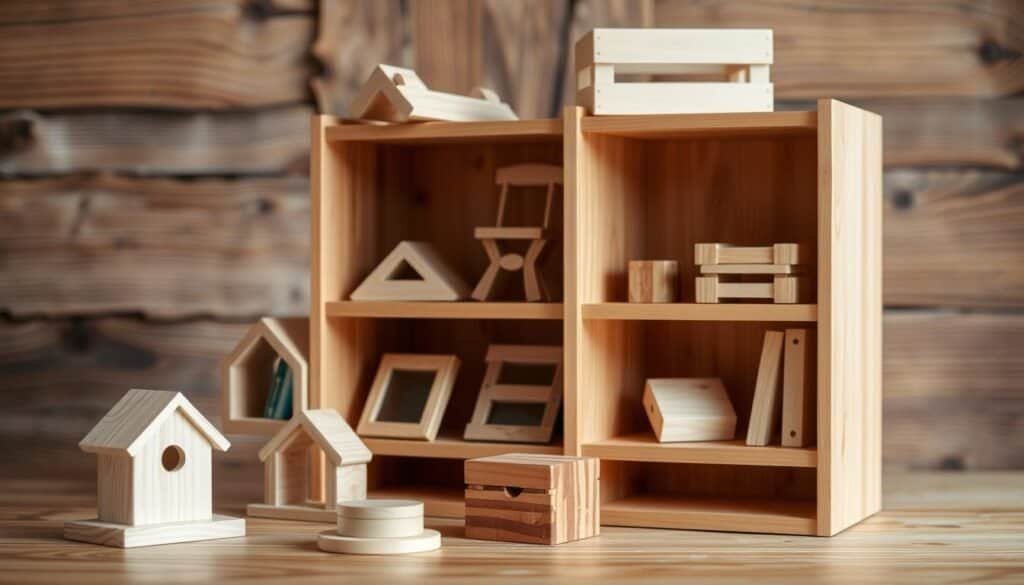
After building the bookshelf, kids learn to organize their books and items. They can arrange their favorite books or decorate the shelf with paint or stickers. This makes it their own.
This project is a good start for kids in woodworking. When they finish, they can show off their work. It’s also a chance to talk about using wood pallets and other creative wood projects.
Working on this project, kids learn about woodworking and grow their creativity and organization skills. It’s a fun and educational activity that can encourage them to try more woodworking projects.
Building a Wooden Toolbox: For Ages8-12
Building a wooden toolbox is a fun project for kids aged 8-12. It teaches them woodworking and how to organize. They learn the basics of carpentry and the value of having a place for tools.
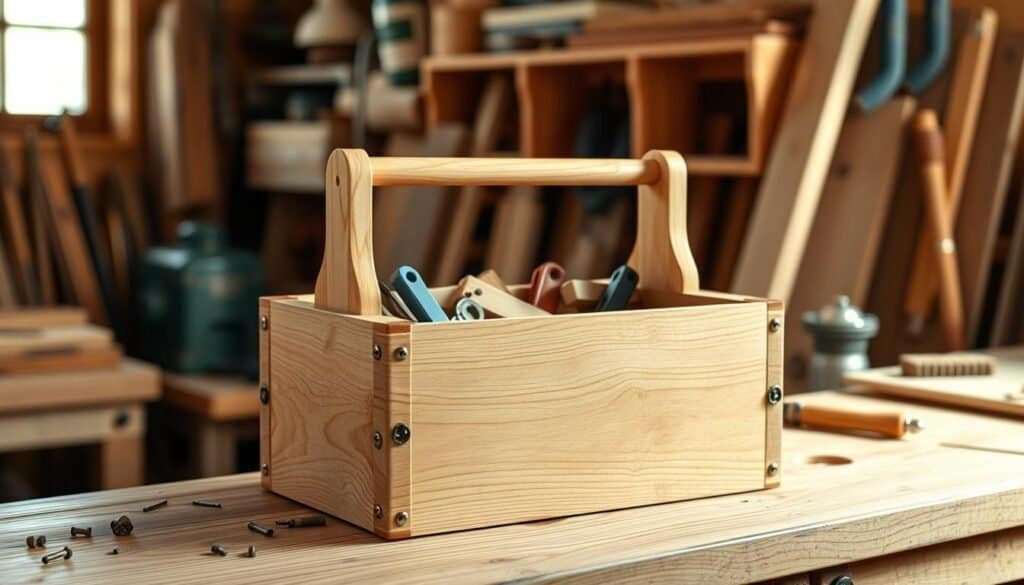
Designing the toolbox lets kids be creative. They decide on size, shape, and features. They can add compartments or a removable tray for better organization. This encourages problem-solving and thinking critically.
Practical Uses and Customization
A wooden toolbox is both practical and customizable. Kids can make it personal by adding their name or choosing a favorite color. This makes the project more fun and meaningful.
The toolbox helps store tools and materials. Kids learn about each item’s use. They see the importance of a clean workspace, like when making a homemade step stool or a wood step stool.
When done, the toolbox keeps the workspace tidy. It’s a mix of woodworking and organization skills. This project offers a full learning experience.
Working on this project improves fine motor skills, hand-eye coordination, and understanding measurements. These skills are key for more complex projects, like building a wooden step stool or creating smart tiles.
Simple Wooden Toys: Beginner Projects for Ages5-7
Making simple wooden toys is a great way to start kids in woodworking. These projects are fun and help them learn important skills like problem-solving and hand-eye coordination.
For kids aged 5-7, it’s important to choose projects that are easy and safe. A wooden car is a good start. It teaches kids about measurements and the need for precision through basic cutting and assembling.
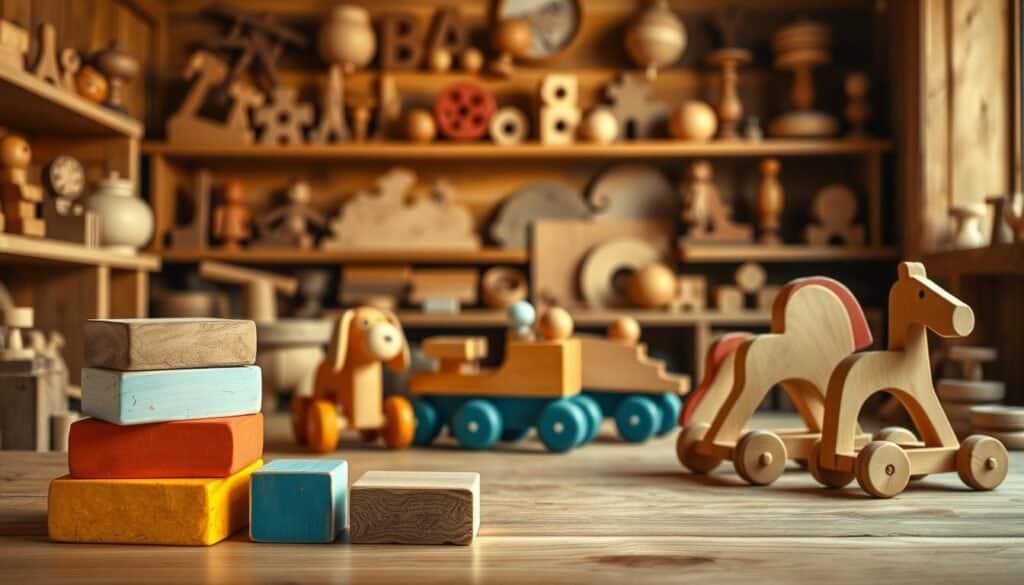
When kids work with wood, safety is key. Make sure they wear goggles and gloves. Always watch them closely, even when they’re using tools.
A wooden puzzle is another fun project. It involves cutting out shapes and putting them together. This project boosts problem-solving skills and encourages creativity.
By following these wood steps carefully, kids can finish their projects well. As they get better, they can try more cool wood projects and explore their creativity even more.
In summary, simple wooden toys are a fantastic way to introduce kids to woodworking. These projects are both fun and educational. They prepare kids for more complex projects in the future, which could even lead to wood projects that sell as they gain more experience.
Wooden Name Plaque: Personalized Project for Ages6-9
A personalized wooden name plaque is a great way to introduce kids to woodworking. This project lets them create a customized plaque. It can decorate their room or be a thoughtful gift.
To start, kids need a piece of wood, a saw, sandpaper, and paint or varnish. First, they cut the wood to the right size. With adult help, they use a saw to cut out their name plaque’s shape.
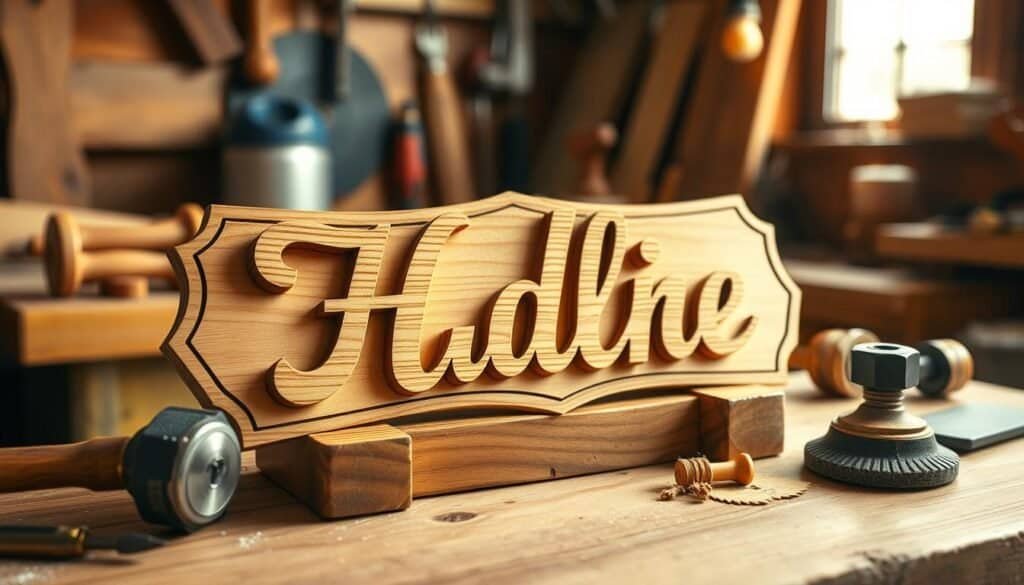
After cutting, they sand the wood to smooth out any rough edges. This step is key. It makes the plaque safe and smooth for painting or varnishing.
Personalization Ideas
Kids can make their plaque special by painting their name in different colors. They can add decorations like stars or hearts. Or, they can use a wood burning tool (with adult supervision) to create detailed designs.
They can also choose the plaque’s shape. Instead of a rectangle, they might pick a heart, a star, or their favorite animal.
After decorating, applying varnish protects the plaque and gives it a glossy look. This step not only makes the plaque look better. It also teaches kids about finishing techniques in woodworking.
Creating a wooden name plaque is a fun and easy woodworking project for kids. It teaches them about measurement, tool use, and the joy of creating something personal.
Building a Bird Feeder: Nature Project for Ages7-10
A bird feeder is a great project for kids starting with woodworking. It encourages them to explore the outdoors and appreciate nature. DIY woodworking projects for children are both fun and educational. They teach kids about feeding wildlife and the basics of woodworking.
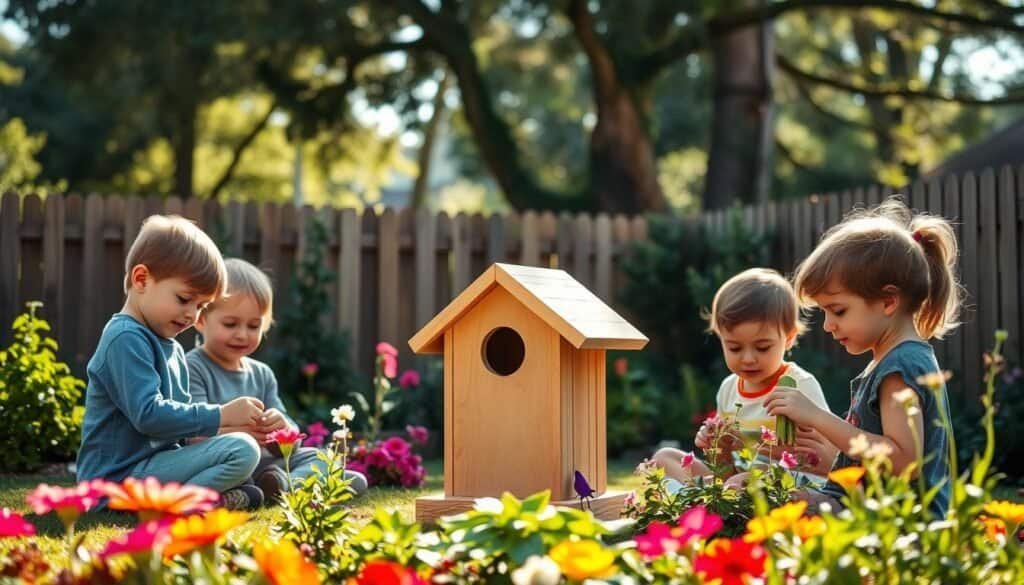
To begin, you’ll need a few simple materials. You’ll need a piece of wood for the base, small wooden sticks or dowels for the perches, a roof, some nails, and a string or wire for hanging. Kids can help measure and cut the wood under adult supervision. They learn about measurements and the safe use of tools.
Assembling the bird feeder involves nailing the sides and base together, then attaching the roof. Children can help with hammering nails gently and filling the feeder with birdseed. This project teaches woodworking skills and about different bird types and their feeding habits.
Installing and Enjoying
Once the bird feeder is built, it’s time to install it. Choose a location that’s easy for kids to observe, like near a window. Make sure it’s securely hung to withstand weather conditions. After installation, enjoy watching the birds visit with your kids. Teach them about different species and the importance of providing food for wildlife.
Building a bird feeder is a rewarding project that combines woodworking with nature. It provides a valuable learning experience for kids. It’s a beginner-friendly project that can spark a lifelong interest in woodworking and the outdoors.
Small Wooden Stool: Intermediate Project for Ages9-12
Building a small wooden stool is a great way for kids to learn and have fun. It’s perfect for kids aged 9-12. They get to improve their skills and learn patience and precision.
This project includes steps like measuring, cutting, and putting the wood together. It’s a great way to teach kids about being accurate and following instructions.
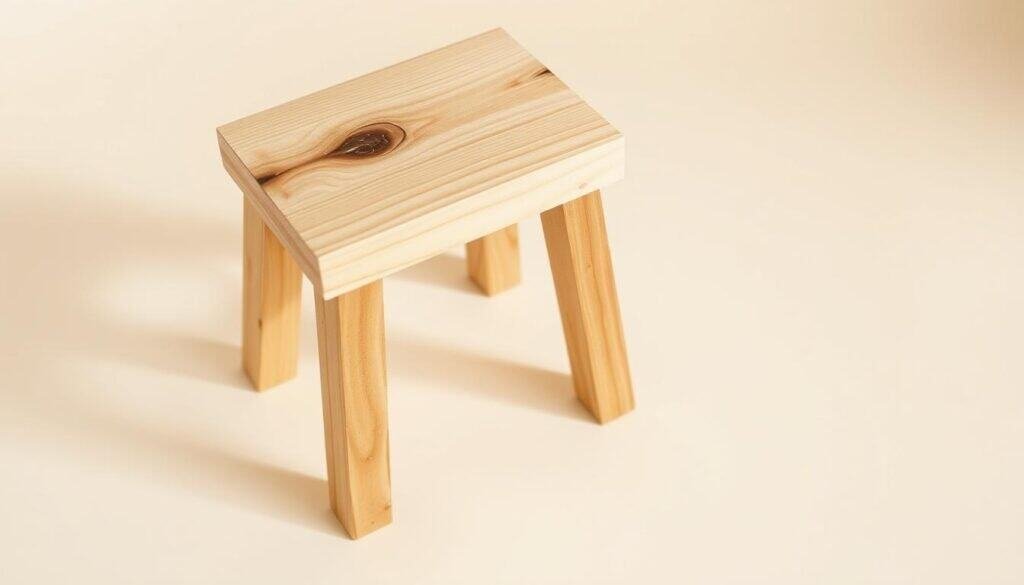
The first step is choosing the right wood and tools. Kids learn about different woods and how to use tools safely.
Practical Uses
A small wooden stool is not just a fun project. It’s also useful in places like a reading nook or a kitchen helper stool.
Finishing this project makes kids feel proud of what they’ve done. It shows them the value of hard work and the joy of making something useful.
Woodworking projects like this teach kids more than just how to work with wood. They learn important skills like problem-solving, critical thinking, and creativity.
Wooden Planter Box: Combining Skills for Ages8-11
A wooden planter box project is a great way for kids to learn woodworking. It’s fun and educational for young builders aged 8-11.
You’ll need basic tools and materials like wood planks, a hammer, nails, and a saw. The project’s level can be changed to fit the child’s skill, making it fun for all.
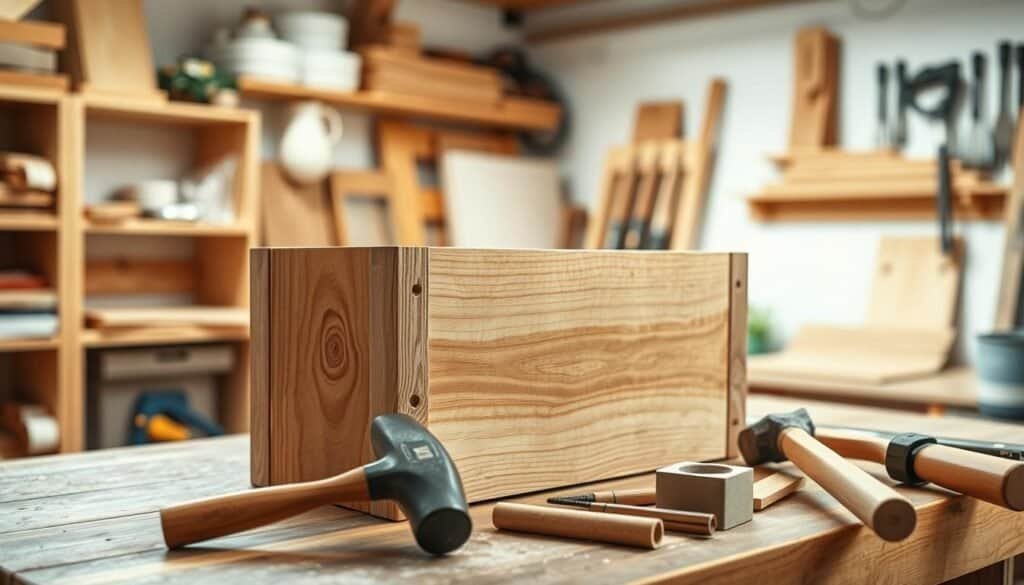
Start by cutting the wood planks to the right size for the planter box. Use nails to put the sides and bottom together. Sand the edges to make them smooth, teaching kids about finishing.
Planting and Maintenance
After building and decorating the planter box, it’s time to plant. Choose easy plants like herbs or succulents for kids to care for. Teach them about planting, like soil, water, and sunlight.
Teach kids to water their plants and watch them grow. This teaches them about gardening and responsibility. It’s a great way to learn woodworking and gardening.
Building a wooden planter box teaches kids many woodworking skills. They learn to measure, cut, assemble, and finish. It’s a creative and practical project for kids.
Woodworking as a Family Activity
Woodworking together as a family is rewarding. It teaches everyone and brings them closer. Working on projects, they share ideas and feel proud of their creations.
Woodworking helps families bond across generations. Parents teach their kids about craftsmanship and safety. This is a great way to pass on skills and values.
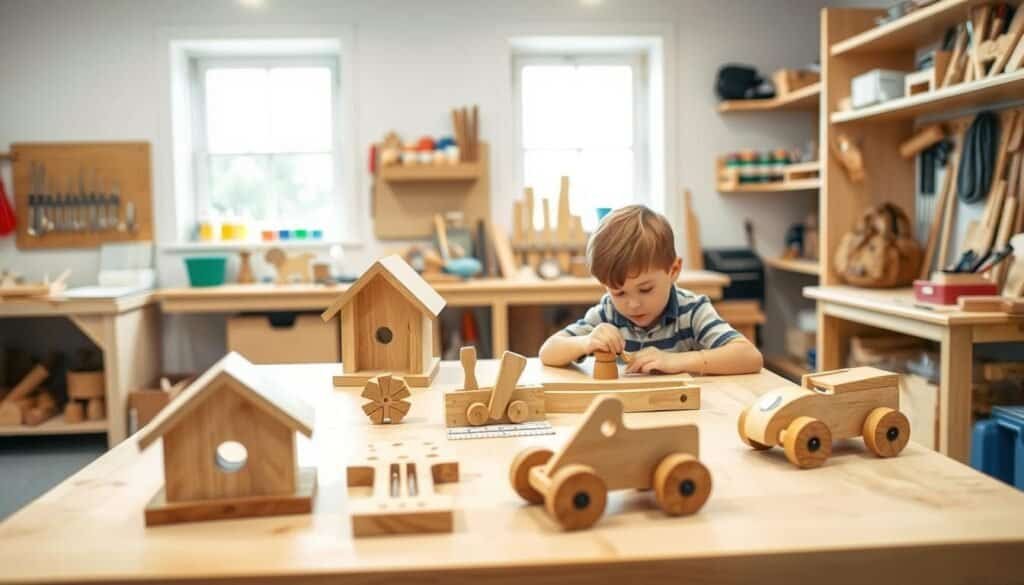
Choosing the right project is key for family woodworking. Start with simple crafts to build confidence and skills. This helps everyone feel more comfortable.
Always stress safety in the workshop. Make sure everyone knows and follows the rules. This keeps everyone safe and happy.
Woodworking projects create lasting memories for families. Whether it’s a birdhouse or furniture, making something together strengthens bonds. It’s a special way to connect and appreciate each other’s efforts.
Advanced Projects for Ages12-15
For kids aged 12-15, advanced woodworking projects are perfect. They help kids become more independent and creative. At this age, they’re ready for tasks that test their skills and teach them to rely on themselves.
Encouraging Independence
These projects let older kids work on their own. They make their own decisions and learn from their mistakes. Building a wooden cabinet or making diy montessori toys are great examples. They teach woodworking and also improve problem-solving and thinking skills.
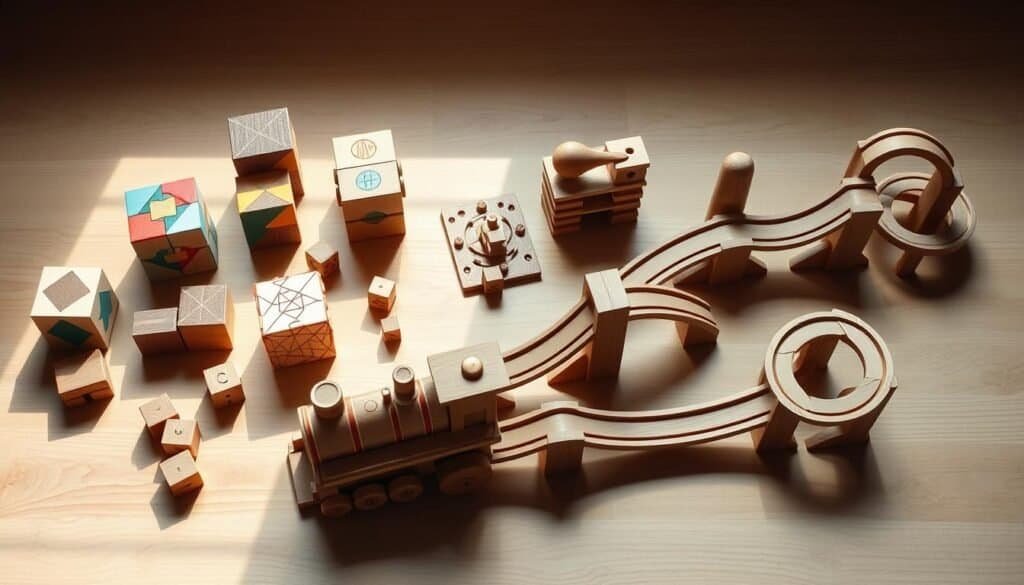
Advanced woodworking projects can match a child’s interests. For example, if a child loves learning, they might enjoy making wooden educational toys. These toys teach concepts like geometry or physics in a fun way.
Another idea is to build montessori wooden toys. These toys are simple yet educational. They help kids learn through play and improve their thinking skills.
Working on these projects gives kids a sense of pride and accomplishment. It boosts their confidence and encourages them to tackle even harder projects later.
Conclusion: Building Skills and Memories Through Woodworking
Woodworking is a great way to boost creativity and skills in kids. It’s also a fun way to spend quality time together. Through woodworking, kids learn to solve problems and improve their hand-eye coordination.
This foundation helps them appreciate DIY projects for years to come.
Continuing the Woodworking Journey
As kids get better, they can tackle more challenging projects. This boosts their skills and confidence. Encouraging them to try different projects helps them understand woodworking better.
It also sparks their creativity for the future.

